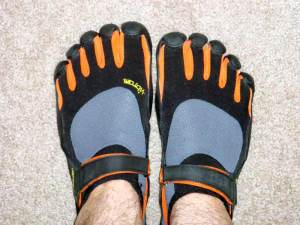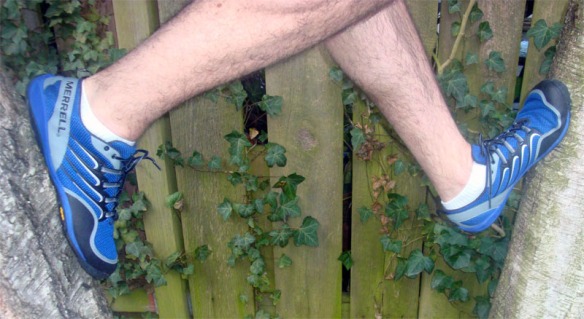 Feet…. for the most part, we all have two of them. We use them every day to get from point “A” to “B” to “C”.
Feet…. for the most part, we all have two of them. We use them every day to get from point “A” to “B” to “C”.
Thousands of years ago, men, women, and children of all social strata were minimally or not at all shod. A typical example of a primitive ‘shoe’ would consist of a strip of leather to protect the bottom of the foot and a strap to keep the leather ‘tied’ to the foot. This was called a Huarache, and there are still tribes (and modern runners) that wear them on a regular basis. They were simple, cheap, and effective.
As ‘civilization’ progressed, different cultures developed different styles of shoe, ranging from simple wooden clogs to silken slippers placed on women’s feet to prevent them from growing correctly at all. Every single shoe had a problem – it took the foot out of the equation of walking.
An Amazing Machine
The human foot is an amazing machine. A fully grown adult will have 26 bones, 33 joints, and dozens of ligaments, tendons, and muscles. They are also contain thousands of nerve endings. All this complexity exists for one thing – to allow a human to walk – or run – from point “A” to “B” to “C”. It is truly an amazing machine, and to have two of them strapped to the lower half of your body is really a stroke of luck, because they are meant to be used in pairs. Of course, they can be used singly, but they “work” together.
The basic idea is this:
- the muscles move the foot into place on the ground.
- the nerves send information to the brain, so the brain can make decisions based on those inputs about how the muscles will react.
- the muscles react according to the brains commands, contracting and relaxing as instructed.
- the muscles, which are attached to the bones via ligaments pull the bones. The tendons help to keep the bones aligned.
- the joints articulate in such a way to keep the foot supported, other joints protected, and the body protected and upright.
A pretty simple process, on paper. Now, enter shoes.
How we went wrong
The first shoes were little more than leather wrappings around the foot. As society, particularly European society, evolved, so did shoes. They became boots which constrained the foot, often fitting poorly with either too much or too little room. Toes changed from blunt boxes to ‘elegant’ points and became quite the symbol of style and affluence. Most shoes were not designed specifically for your left or right foot, but were rather uni-fit shoes, which would just go on whichever foot you pulled them onto.
Your foot’s nerves, ligaments, bones, and muscles were given no consideration at all. And why should they? The need to run, jump, and be limber and nimble was something from a fanciful past where one had to chase live animals for food, or run from predators. It was barbaric. Shoes which did not cater to the gymnastic past of our predecessors were a symbol of how far societies had come. There was nothing primal to fear, any more, so why bother keeping your body, mind, and nervous system tuned up for such an endeavor? Better to keep it tuned for enjoying music, or food, or fine clothing.
And that’s pretty much the way it stayed until societies advanced enough that we could begin making rubbers, and plastics, and machines that could build a reliable product over and over and over again. Which is exactly what happened. Shoes were growing up, baby, and they were softer, more supple, and more colorful than ever! We could make all kinds of different shoes for different activities, with different levels of cushion and heel drop, different uppers and colors and fabrics and wizzbangery. Our feet were just getting more and more awesome with every iteration.
But they really weren’t.
The shoes, with their arch supporting, torsion controlled lumps and ridges do not t actually help our feet at all. They effectively freeze many of the muscles and joints into a fixed place within the shoe. Because of this, the nerves send out alarms to the brain, to let the brain know that something is going on with the foot. The brain knows that there’s nothing exactly wrong, and eventually just turns off the song and dance offered up by the nerves, kind of the way it tunes out the car alarm that is always going off in the parking lot. The modern shoe turns the foot into one large monolithic slab, causes our bodies to strike our heels on the ground when we walk and run, and just generally destroys our gait. The shoe is designed to mitigate this – through gels, air, and multi-desnsity foams – and make your foot feel as though it is moving atop a fluffy cloud of goo.
And it gets worse
It appears as though the more sophisticated shoes get – offering increased arch support, stability, etc – the more the foot can relax and get lazy. This leads to all kinds of issues – foot and ankle injuries such as sprained tendon, plantar fasciitis, tendonitis, pulled muscles, and damaged and degraded joints. The foot, allowed by the shoe to be lax, also loses its natural arch.
Arches are a girl’s best friend (and you thought it was diamonds)
The body is full of arches. There are arches in the spine, legs, and, yes, feet, that help reduce shock from activity, including walking, running, and jumping. Without our arches, we are more prone to injury, and can even face aggravated injury from the lack of our body’s natural shock absorption. For instance, an incorrectly aligned spine can actually increase the force of an accident instead of dissipate the force. When you lose an arch, you potentially face increased pain and risk of injury. So it’s important to keep all your arches healthy.
But I’ve already lost my foot arches. Is all hope lost?
Modern medical treatment of fallen arches and other foot issues is through the use of orthotics. However, recent studies into the somewhat mysterious field of orthotics reveal one thing – that they don’t know what in the hell they are talking about. There seems to be little science and more art, guesstimation, and downright dumb luck in finding a good orthotic. Good thing, too, because these babies aren’t always cheap. The orthotics industry makes millions upon millions of dollars every year in the US. From Dr. Scholl’s to Superfeet to custom orthotics, many living in the US turn to orthotics to offer some relief to their feet. But adding something else, it seems, is not what the foot needs at all.
Another recent study by Dr. Nirenberg found that increasing barefoot or barefoot-like activities led to an increase and return of the natural foot arch. Bolstering this study is many anecdotal stories across the western world describing how barefoot activies led to a return of the foot’s natural arch and improved function as well as reduced pain levels and injury risks.
So what are you waiting for?
Get out there and go barefoot!
Not ready to jump in whole-hog? No problem. There are lots of shoes out there designed to help you make the transition.
www.vibramfivefingers.com
www.merrell.com/US/en/Barefoot
birthdayshoes.com/fila-skeletoes-toe-shoes-exclusive-sneak-peak
www.softstarshoes.com/index.cfm










